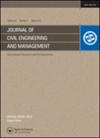城市铁路建设事故中不安全行为的风险传递特征探讨
IF 3.7
3区 工程技术
Q1 ENGINEERING, CIVIL
引用次数: 6
摘要
各种施工事故已被证明是由多种不安全行为(如错误使用个人防护用品)引起的,但不同行为之间的风险传递尚不清楚。本文从系统安全的角度深入了解了通过行为风险链导致事故的风险传递。为了更好地理解各种不安全行为的耦合机制,整合不同的行为风险链,呈现风险传递过程,采用了有向加权复杂网络(DWCN)方法。通过对我国城市铁路建设历史事故的调查,提取行为风险链。将DW-BRCNA应用于集成行为风险链,通过度和度分布、节点强度和节点强度分布、平均路径长度和直径、加权聚类系数和介数中心性五个网络特性,探索和阐明了行为风险的传递特征。结果表明,DW-BRCNA具有小世界、无标度和分级网络的特征,表明在通过行为风险链进行风险传递的过程中,一些不安全行为具有更大的重要性。此外,关键行为风险链中的风险传递更有可能导致事故。本研究从不安全行为之间的风险传递出发,提出了事故原因分析的新视角。它通过基于行为风险链的DWCN方法来解释风险传播特征。研究结果还为制定现场控制策略以防止风险传播和减少事故提供了实际指导。本文章由计算机程序翻译,如有差异,请以英文原文为准。
EXPLORING THE RISK TRANSMISSION CHARACTERISTICS AMONG UNSAFE BEHAVIORS WITHIN URBAN RAILWAY CONSTRUCTION ACCIDENTS
Various construction accidents are proven to be caused by multiple unsafe behaviors (e.g., wrong use of PPE), but the risk transmission among different behaviors remains unclear. This paper provides insight into risk transmission through behavioral risk chain that leads to accidents from a system safety perspective. To better understand the coupling mechanism of various unsafe behaviors, integrate different behavioral risk chains and present the risk transmission process, a directed-weighted complex network (DWCN) method was adopted. Historical urban railway construction accidents in China are investigated to extract behavioral risk chain. A DW-BRCNA is applied to integrated behavioral risk chain and the behavioral risk transmission characteristics are explored and clarified by the five network properties, including degree and degree distribution, node strength and node strength distribution, average path length and diameter, weighted clustering coefficient and betweenness centrality. The results show that DW-BRCNA has the characteristics of a small-world, scale-free and hierarchical network, indicating that some unsafe behaviors are of greater importance in the process of risk transmission through behavioral risk chains. In addition, risk transmission in critical behavioral risk chains is more potentially to lead to accidents. This study proposed a new perspective of accident causation analysis from risk transmission among unsafe behaviors. It explains the risk transmission characteristics by a DWCN method based on behavioral risk chains. The findings also provide a practical guidance for developing control strategies on sites to prevent risk transmission and reduce accidents.
求助全文
通过发布文献求助,成功后即可免费获取论文全文。
去求助
来源期刊

Journal of Civil Engineering and Management
ENGINEERING, CIVIL-
CiteScore
6.70
自引率
4.70%
发文量
0
审稿时长
1.7 months
期刊介绍:
The Journal of Civil Engineering and Management is a peer-reviewed journal that provides an international forum for the dissemination of the latest original research, achievements and developments. We publish for researchers, designers, users and manufacturers in the different fields of civil engineering and management.
The journal publishes original articles that present new information and reviews. Our objective is to provide essential information and new ideas to help improve civil engineering competency, efficiency and productivity in world markets.
The Journal of Civil Engineering and Management publishes articles in the following fields:
building materials and structures,
structural mechanics and physics,
geotechnical engineering,
road and bridge engineering,
urban engineering and economy,
constructions technology, economy and management,
information technologies in construction,
fire protection, thermoinsulation and renovation of buildings,
labour safety in construction.
 求助内容:
求助内容: 应助结果提醒方式:
应助结果提醒方式:


